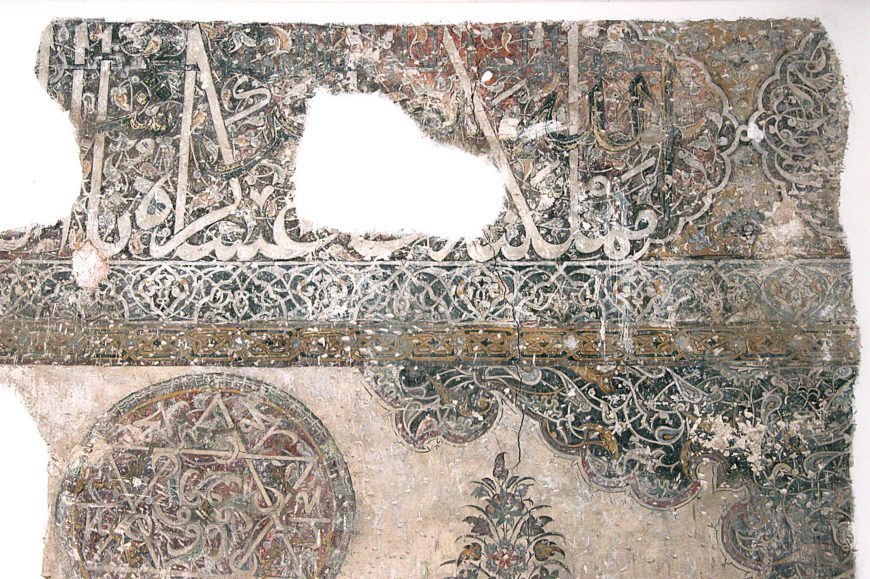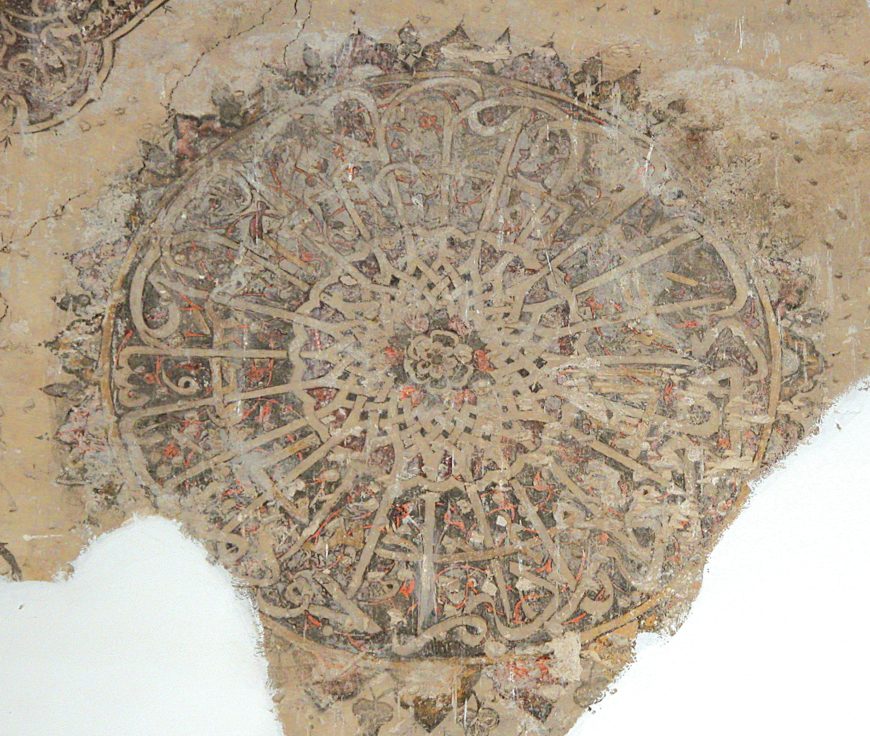The Muradiye Mosque is situated on a hilltop outside the Turkish city of Edirne, the capital of the Ottoman Empire from 1413 to 1458. And although it appears modest from the outside, the interior is covered with wall paintings and colorful tiles—like a museum of fifteenth-century Ottoman architectural decoration. The lavish tiles and frescoes are witness to the interconnected nature of the Ottoman artistic world with Central and East Asia.
The mosque, commissioned by sultan Murad II, was once part of a multi-functional architectural complex with a prayer hall, a soup kitchen, and a residence hall. Originally designed as a convent-mosque, it once housed multiple functions, including daily prayer, mystical rituals, and accommodation for travelers, though today it serves only as a mosque.
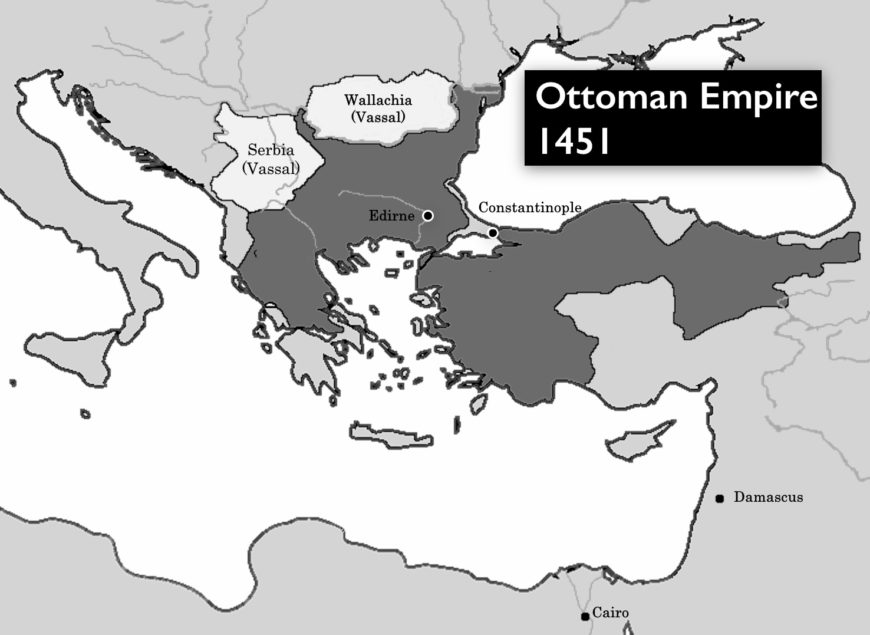
Ottoman Empire in 1451, before the conquest of Constantinople in 1453 (map: Chamboz, CC BY-SA 4.0). The Ottomans emerged as a frontier principality bordering the Byzantine Empire in western Asia Minor at the turn of the fourteenth century. By 1430s, they took the control of Anatolia and after the conquest of Constantinople in 1453 their empire expanded toward southeast Europe.
Built for the Mevlevis
The Muradiye convent-mosque is the first convent in Ottoman territories built by an Ottoman patron for the Mevlevis, a Sufi order known for their whirling ritual, in which dervishes perform a dance accompanied by the play of musical instruments and recital of Sufi poems. [1] According to a myth, the sultan Murad II dreamed of a meeting with Jalal al-Din Rumi—the thirteenth-century Sufi poet and saint—on this spot and vowed to build a lodge there for Mevlevis. It is possible that as Murad II reconquered western Anatolia and the Aegean region and was trying to consolidate his authority there, he sought to forge an alliance with the Mevlevis because of their social influence over the western part of Anatolia.
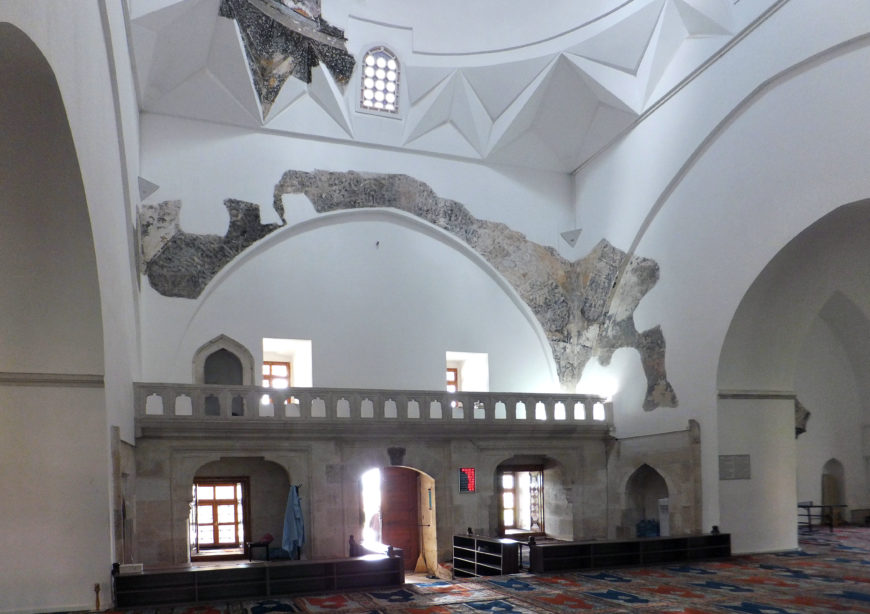
View toward the entrance way, with the gallery above. Muradiye Mosque, Edirne, c. 1433 (Turkish Archaeological News)
Plan and history
The Muradiye more or less follows an architectural plan referred to as an inverted T-type, a building type that was ubiquitous in Ottoman towns during the fourteenth and fifteenth centuries.
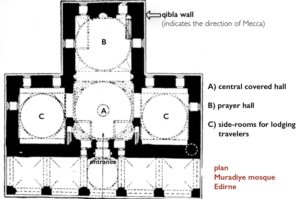
Plan, Muradiye Mosque, Edirne (Salt Research, CC BY-NC-ND 4.0)
To create an inverted T-shape, this architectural form is commonly composed of:
- a central covered hall
- a prayer hall on the qibla side often built on a higher elevation than the central space
- two side-rooms for lodging travelers
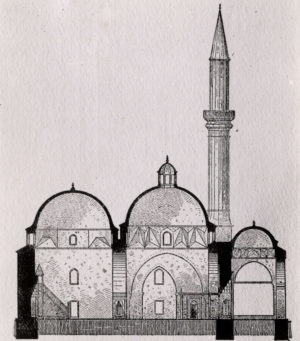
Elevation, Muradiye Mosque, Edirne (Salt Research, CC BY-NC-ND 4.0)
Past the main entrance, a gallery (an upper level that allows a view to the main space) overlooks the central hall and was likely used by Mevlevi musicians, who provided musical accompaniment for the whirling rituals which probably took place in the central hall.
Just past the entrance, a water fountain and water spouts were recently discovered during restoration work. These may have served to distribute ritual water to visitors, demonstrating that this building initially housed Mevlevi rituals alongside daily activities such as prayer and lodging.
Sometime later, the convent-mosque was converted into a congregational mosque and the Mevlevis were moved out, and a new ritual hall, and a dervish lodge were built to the north. Sultan Murad II decided to evict the Mevlevis, probably for political reasons between 1435 and 1453. The transformation into a mosque involved lowering the prayer hall to the same level as the central hall and demolishing the walls between the side rooms and the central hall. An unobstructed interior space was created to house Friday prayer.
Interior decoration
Tilework
The interior of the Muradiye is beautifully decorated, with fragmentary wall paintings discovered in restorations undertaken during the 1950, as well as blue-and-white and cuerda seca tiles (often called “black-line tiles”).
These remarkable cuerda seca tiles have a precedent in tiles made in the city of Samarkand in Central Asia, which was built by the ruler Timur in the 1390s. At the same time, blue-and-white porcelain from China was sought after and imported in large quantities to Egypt, Syria, and Iran mostly through maritime routes since the fourteenth century. Under Timur’s rule in Iran, Chinese porcelain inspired local workshops to produce blue-and-white objects and architectural tiles. Timur’s invasions throughout western Asia created a fluid zone for the movement of artists and craftspeople, along with manuscripts and objects, which was productive for the transmission of artistic forms, techniques, and ideas. Although the Ottomans were defeated by Timur in 1402 at the Battle of Ankara, as patrons they endorsed and implemented Timur’s aesthetic tastes.
The lower sections of the eastern and western wall of the prayer hall are covered with hexagonal blue-and-white tile panels with a variety of floral motifs and geometric designs and a framing border. More than four hundred of these beautiful original blue-and-white tiles were stolen in 2001, and their original location is currently plastered over. While it is not known how blue-and-white tiles arrived in Ottoman lands, their presence in the Muradiye demonstrates that Edirne and Ottoman lands more generally were interconnected with central Asia through trade networks.
The mihrab is the eye-catcher of the interior, with polychrome glazed cuerda seca tiles. The color palette here is diverse—exhibiting dark and turquoise blue, yellow, and white, and the composition includes eight-pointed stars and various vegetal motifs such as split-palmette leaves and flowers.
Composed of square and rectangular tile panels, the mihrab contains an inscription from the Qur’an (the sacred text of Islam) running across its three sides and another in the center. [2]
Wall PaintingsOccupying most of the side walls in the prayer hall is what appears to be a painted garden scene. In this garden, is a cypress tree wrapped by ivy, an oblong flower bouquet, what appear to be fruit trees, and various plants and flowers springing from the earth. The beholders find themselves in a verdant and blooming landscape.
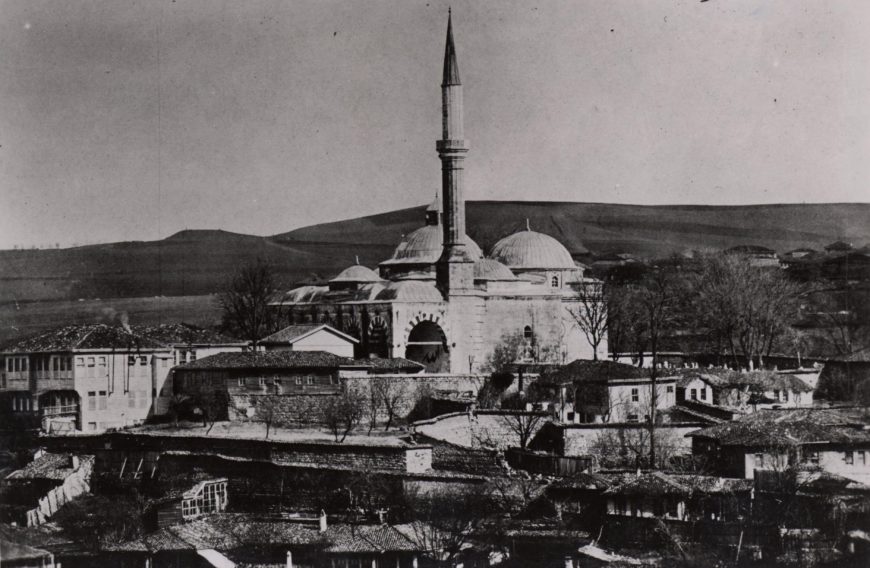
Muradiye Mosque, Edirne, photograph, 1920s, 16.1 x 10.7 cm, Salt Research (CC BY-NC-ND 4.0). The architectural complex of which the Muradiye mosque-convent was part also included a soup kitchen, where soup and bread were cooked and given to dervishes and travelers daily, free of charge. These structures existed (on the left side of the photo before the mosque) until the end of the 1920s when the dervish lodge was closed, and in 1935 those buildings which were in a dilapidated state were taken down.
The Muradiye convent-mosque is located just outside Edirne proper, in an area which was then an undeveloped suburban idyll. A photograph of the building from the 1920s, taken from a birds-eye view, shows such an area, dotted with cypress trees. The painted gardens may reflect the exterior setting of the building—bringing the outside nature to the inside. Natural trees and flowers that change with the seasons and weather conditions are rendered permanent here. The Mevlevis claimed that they preferred to settle on the peripheries of the cities to stay away from mainstream religious people whom they considered “immature souls.” These paintings might have played a key role visually for Mevlevi’s self-representation: portraying solitude, isolation, and detachment from the material world. At the same time, this convent-mosque was open to a larger audience than the Mevlevis alone, including an array of travelers. The landscape images may have meant something different to these various visitors.
Inscriptional program
The interior of the Muradiye is decorated with inscriptions which are meant to be read by worshipers and travelers and most are verses from the Qur’an. Found at the end of the lower inscription frieze in the prayer hall is another inscription written in angular script. It contains part of a Quranic verse (26:37): “in temples God has allowed to be raised up and His Name to be commemorated therein; therein glorifying Him, in the mornings and the evenings, are men whom neither commerce nor trafficking diverts from the remembrance of God.” These verses are fitting for this particular part of the convent-mosque, as prayer would take place here. Believers would recite and listen to the Qu’ran and remember the name God and gather to perform Islamic daily prayers toward the Kaaba (the holiest shrine in Islam) in the presence of an imam (prayer leader of a mosque). These inscriptions reinforce the identity of the building as a communal space and probably because they refer to the value of worship to God they were later retained for the Friday mosque.
The patron’s name, sultan Murad II, is also visible in the painted inscriptions. Hovering over garden scenes, a medallion written in rotating angular and cursive scripts eulogizes Murad II as follows: “Oh the glorious one, endowed with the eyesight, possessor of the proof; o sultan Murad Khan, o enduringly generous and munificent, o the sultan of every sultan, the gracious.” These celebrations are probably not an ordinary eulogy for a sultan. The inscriptions may well be designed to proclaim and celebrate Murad as the uncontested Ottoman sovereign, after he defeated and executed two other princes who challenged his ascension to the throne.
The Muradiye in Edirne is the Pandora’s box of early Ottoman art. We still do not know precisely why Murad II decided to move Mevlevis out of the building, or when exactly the convent-mosque’s conversion and transformation into a mosque took place. Its inscriptions that are prominently displayed and clearly legible were most probably designed to convey political propaganda. The lavish and colorful tiles and frescoes are also witness to the interconnected nature of the Ottoman artistic world with western and central Asia.

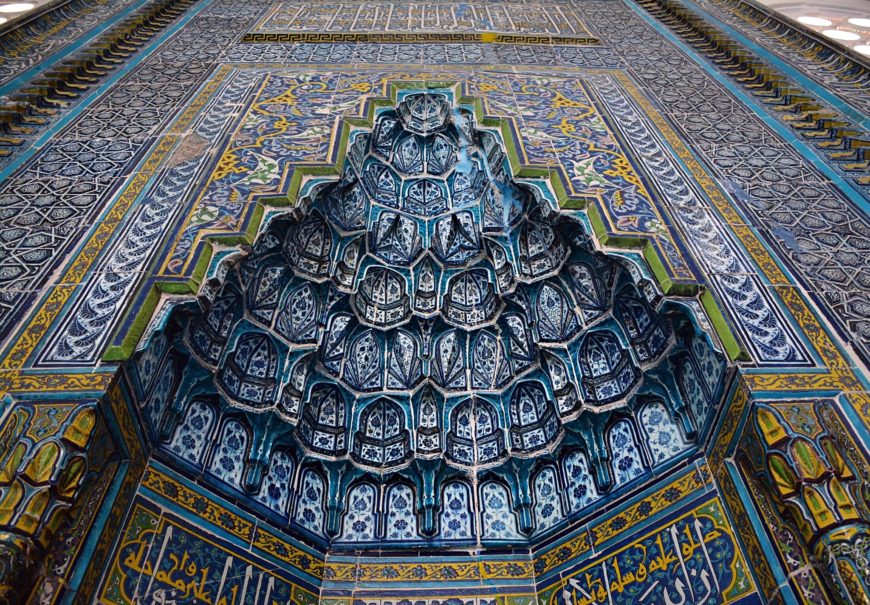
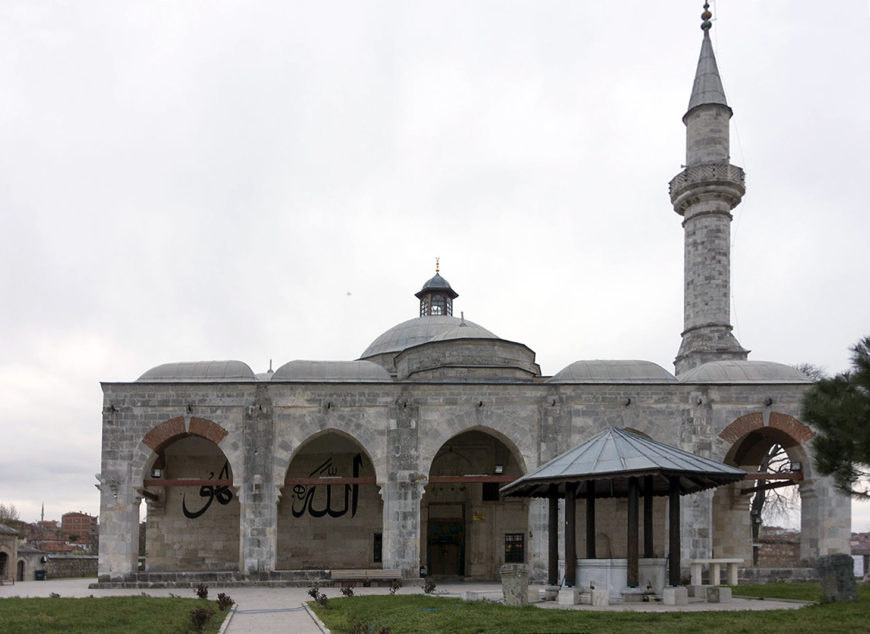
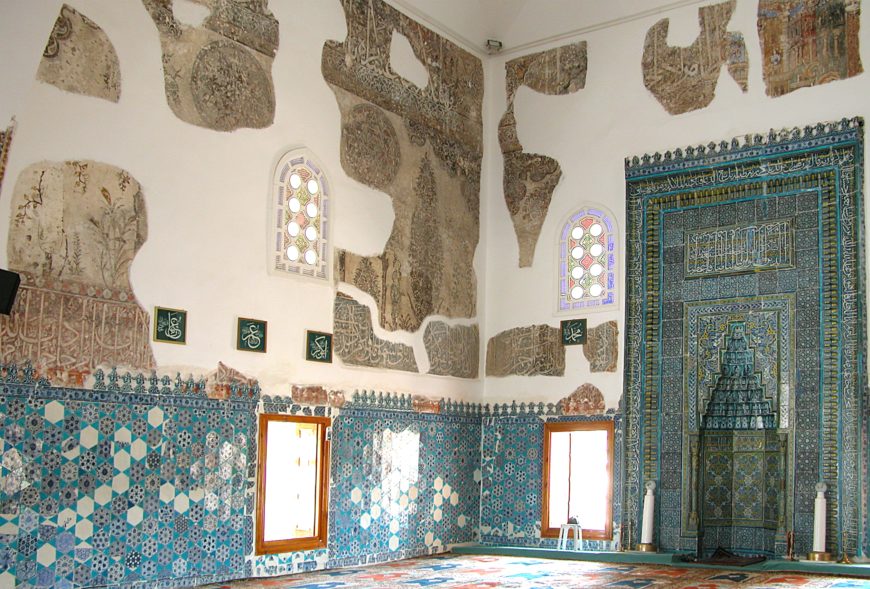
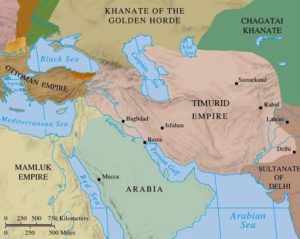
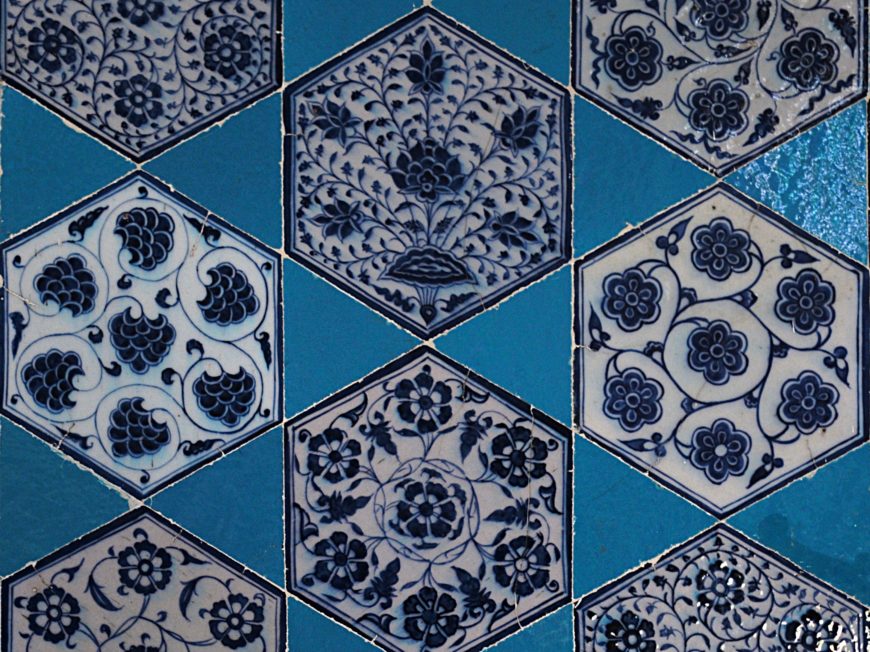
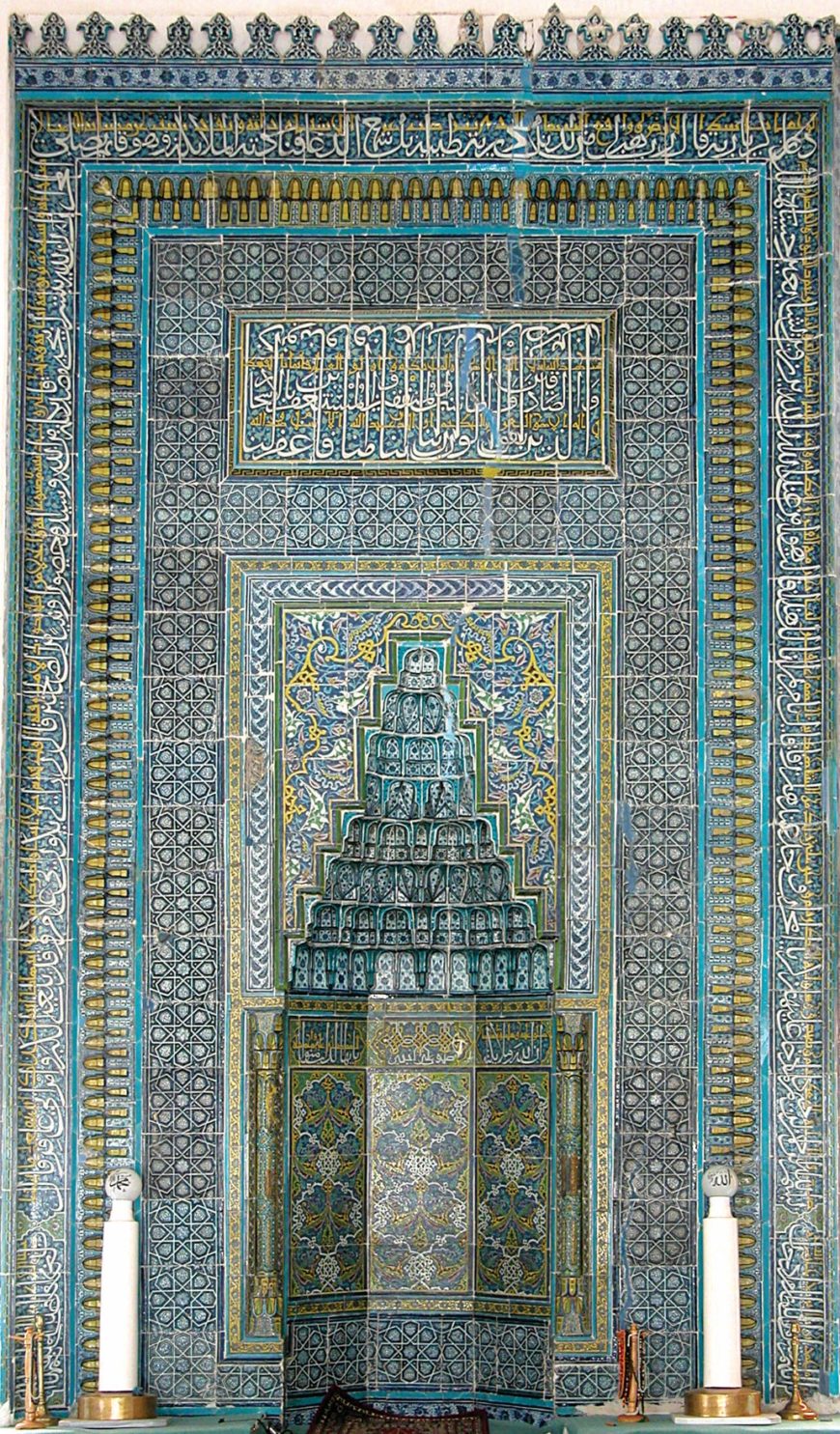
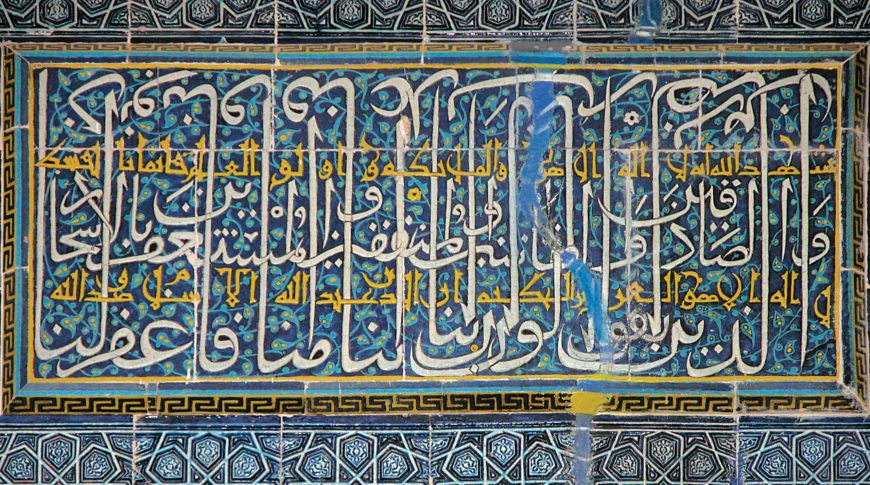
![Muradiye Mosque, Edirne[garden depictions in the prayer hall]](https://smarthistory.org/wp-content/uploads/2022/07/11-870x550.jpg)
